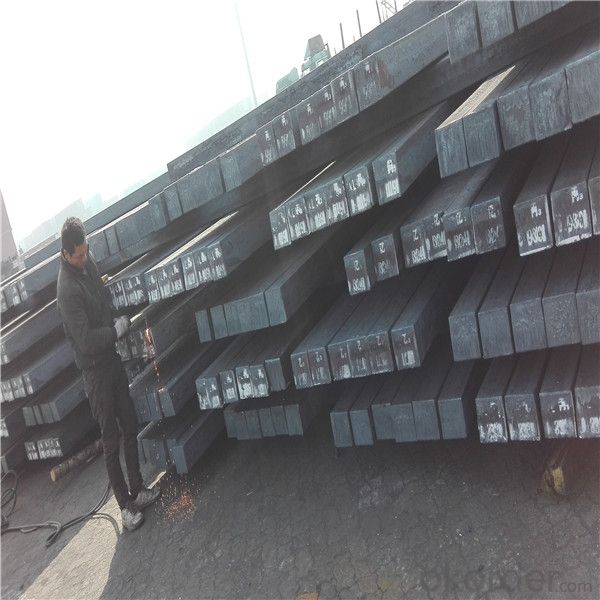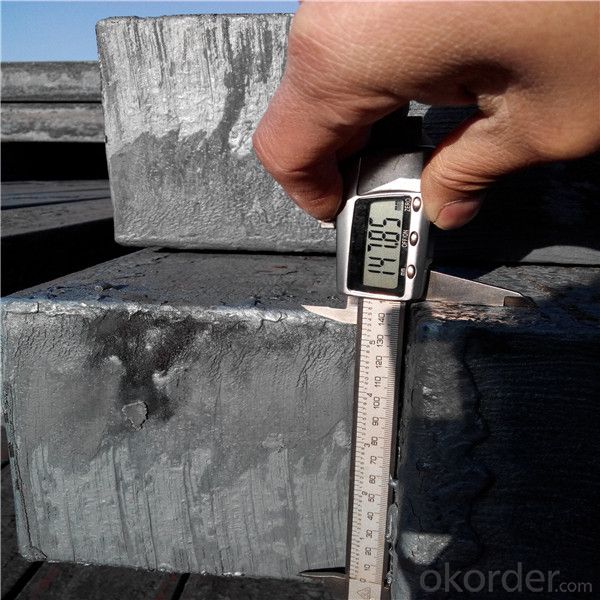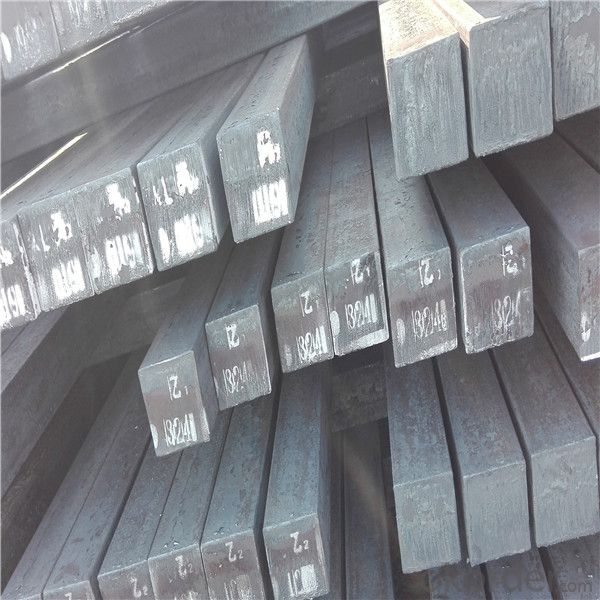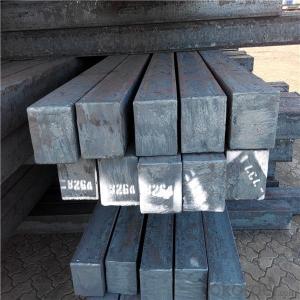Prime concast square steel billet in different size
- Loading Port:
- China main port
- Payment Terms:
- TT OR LC
- Min Order Qty:
- 1000 m.t.
- Supply Capability:
- 18312 m.t./month
OKorder Service Pledge
OKorder Financial Service
You Might Also Like
Item specifice
Steel billet :
Steel billet(ingot) by cogging or breakdown of semi-finished products, is the raw material of all kinds of steel mill. Billet section of square, round, flat,
rectangular and abnormity of several kinds of, mainly related to the shape of rolled products.
The billet is mainly divided into two kinds from the shape:
Slab: cross section width and height of the ratio of the larger, mainly used for rolling plate.
Billet: equal cross section width and height, or a huge difference, mainly used for rolling steel, wire rod. ,
Gade:
Standard | C(%) | Mn(%) | S(%) | P(%) | Si(%) |
Q195 | ≤0.12 | ≤0.50 | ≤0.040 | ≤0.035 | ≤0.30 |
Q235 | ≤0.20 | ≤1.40 | ≤0.045 | ≤0.045 | ≤0.35 |
Q275 | ≤0.22 | ≤1.50 | ≤0.045 | ≤0.045 | ≤0.35 |
20MnSi | 0.17-0.25 | 1.2-1.6 | ≤ 0.050 | ≤ 0.050 | 0.40-0.80 |
3SP | 0.14-0.22 | 0.40-0.85 | ≤ 0.050 | ≤ 0.040 | 0.05-0.15 |
5SP | 0.28-0.37 | 0.50-1.00 | ≤ 0.050 | ≤ 0.040 | 0.15-0.30 |




Our Advantage
* Professional Personnel of Steel Trading
* Strong Steel Industry Background
* Conveniently Geographic Location
Our Commitment
* Sincere, Practical, Efficient and Developing
* High Quality Steel Production
* Competitive Price and Timely Delivery
Packing :
Within 30 days
1.Standard export package
2.In bundles with steel strips
3.As the requirements of the customers
FAQ:
Q: How to get quotation?
A: When we receive your detailed enquiry, we will set the best price based on standard,
steel grade, outer diameter, wall thickness, quantity, country.
And we will send quotation to your mailbox.
Q:How to guarantee the quality of the products?
A:We have established the international advanced quality management system,every link from raw material
to final product we have strict quality test;We resolutely put an end to unqualified products flowing into the market.
At the same time, we will provide necessary follow-up service assurance.
Q:How long can we receive the product after purchase?
A :In the purchase of product within three working days, We will arrange the factory delivery as soon as possible.
The pecific time of receiving is related to the state and position of customers.
- Q:How are steel billets used in the production of industrial valves?
- Steel billets are used in the production of industrial valves as they serve as the raw material for shaping and forming various valve components, such as bodies, bonnets, stems, and discs. Through machining, forging, and welding processes, the steel billets are transformed into the required shapes and sizes, ensuring the strength and durability of the valves.
- Q:How do steel billets contribute to the environmental sector?
- Steel billets contribute to the environmental sector by promoting sustainability and reducing carbon emissions. They are a crucial raw material in the production of various steel products, including construction materials, automobiles, and appliances. Steel billets are typically made from recycled scrap metal, reducing the need for mining and conserving natural resources. Additionally, the steel industry has made significant advancements in energy efficiency and emission reduction, making steel billets a more environmentally friendly choice compared to other materials.
- Q:What are the different types of steel billet extrusion processes?
- The manufacturing industry utilizes various steel billet extrusion processes, each with its own distinct characteristics. These processes employ high pressure to shape solid steel billets into desired profiles or shapes. 1. The most frequently employed method is direct extrusion. This process involves placing the billet within a container, commonly referred to as a "container" or "container die." The container possesses a small opening, known as a "die," through which the billet is propelled using a ram or piston. The billet is then forced through the die, resulting in the formation of the desired shape. 2. Another technique, indirect extrusion, involves a stationary container die. The billet is pushed through the die using a punch or ram. The billet is positioned inside a hollow chamber called a "container" or "container die," featuring a smaller opening at one end. Pressure is applied to the billet using the punch, compelling it to flow through the die and adopt the desired profile. 3. Impact extrusion shares similarities with direct extrusion but incorporates a specially designed punch. This punch strikes the billet with a significant impact force, causing it to flow and take on the shape of the die. Impact extrusion is frequently utilized to produce small, intricate shapes with thin walls. 4. Hydrostatic extrusion employs a sealed chamber filled with a pressurized fluid, typically oil or water, in which the billet is placed. The fluid pressure is utilized to force the billet to flow through the die and acquire the desired shape. Hydrostatic extrusion is commonly employed for the production of complex shapes with high precision. 5. Cold extrusion is performed at room temperature without the need for heating the steel billet. This method is often used to produce small, intricate parts with high dimensional accuracy. It offers a cost-effective approach, enabling the production of parts with excellent surface finish. The selection of a specific steel billet extrusion process depends on various factors, including the desired shape, size, material properties, and production requirements. Each process has its own advantages and limitations.
- Q:How do steel billets contribute to the manufacturing of HVAC systems?
- The role of steel billets in the manufacturing of HVAC systems is crucial. These systems rely on strong and durable components to ensure efficient operation and longevity, and steel billets serve as the foundation for such components. To begin with, steel billets are utilized to construct the primary structural framework of HVAC systems. This framework, also known as the casing or housing, offers support and protection for the internal components including heat exchangers, fans, and coils. Steel billets possess high strength and rigidity, making them an ideal choice for creating a sturdy and dependable framework that can withstand the various stresses and strains encountered during system operation. Furthermore, steel billets are employed in the production of various internal components of HVAC systems. For instance, steel billets are commonly used to manufacture heat exchangers, which play a crucial role in transferring heat between the air and the refrigerant. Steel's high thermal conductivity and corrosion resistance make it an excellent material for these critical components, ensuring efficient heat transfer and long-term performance. Moreover, steel billets are utilized in the manufacturing of ductwork. Ductwork consists of a network of pipes or channels that distribute conditioned air throughout a building. Steel billets are often rolled and formed into the necessary shapes to create the ducts. The strength and durability of steel guarantee that the ductwork can withstand the pressure differentials and mechanical stresses associated with air movement, thereby maintaining the integrity of the system and preventing leaks. Additionally, steel billets are essential for the production of HVAC system supports and brackets. These components are responsible for securely mounting various equipment, such as air handling units or condensing units. Steel's strength and load-bearing capacity make it an ideal material for ensuring the stability and proper installation of these crucial elements. In conclusion, steel billets are vital in the manufacturing of HVAC systems as they provide the necessary strength, durability, and thermal properties for the structural framework, internal components, ductwork, and supports. Without steel billets, it would be extremely challenging to produce HVAC systems that deliver efficient heating, ventilation, and air conditioning to buildings.
- Q:How are steel billets used in the manufacturing of agricultural machinery parts?
- Steel billets are an important raw material in the manufacturing of agricultural machinery parts. These billets are essentially semi-finished steel products that are used as a starting point for various manufacturing processes. Firstly, steel billets are shaped into specific forms using various techniques such as casting, rolling, or extrusion. These processes help transform the solid billets into desired shapes, such as bars, rods, or sheets, which are then used as base materials for agricultural machinery parts. Once the billets are shaped, they are further worked upon through machining, cutting, and welding processes to create specific components for agricultural machinery. For example, billets can be machined into shafts, gears, or axles that are essential for the functioning of these machinery parts. Moreover, the strength and durability of steel billets make them suitable for applications in heavy machinery like tractors, combines, or harvesters. Agricultural machinery parts made from steel billets possess high tensile strength, resistance to wear and tear, and can withstand the demanding conditions encountered in the agricultural sector. In addition, steel billets can be heat-treated to enhance their mechanical properties, such as hardness or toughness, making them more robust and capable of withstanding heavy loads and extreme conditions. This makes them ideal for agricultural machinery parts that often face intense forces during operation. Furthermore, steel billets can be used in the manufacturing of precision components, such as bearings or bushings, which are crucial for smooth and efficient operation of agricultural machinery. The dimensional accuracy and consistency of steel billets ensure that these precision parts fit perfectly and function effectively. Overall, steel billets play a vital role in the manufacturing of agricultural machinery parts. Their versatility, strength, and ability to be shaped and processed make them an essential material in producing components that can withstand the demanding and challenging conditions of the agricultural industry.
- Q:What are the common shipping methods for steel billets?
- Steel billets can be shipped using different methods, including container shipping, bulk shipping, and rail transportation. Container shipping is commonly used when transporting smaller quantities of billets. Billets are loaded into standard shipping containers, usually 20 or 40 feet long, and then transported by cargo vessels. This method is convenient and ensures the safety of the billets during transit. Bulk shipping, on the other hand, is preferred for larger quantities of steel billets. In this method, billets are loaded directly onto cargo vessels without using containers. This allows for cost-effective transportation of large volumes of billets. Specialized bulk carriers are designed to handle heavy cargo and ensure secure delivery. For domestic or regional transportation, rail transportation is a popular option. Steel billets are loaded onto specialized railcars that can carry heavy loads, and they are transported through rail networks. This method offers efficient and reliable transportation, especially for shorter distances. Ultimately, the choice of shipping method for steel billets depends on factors such as quantity, destination, cost, and logistical capabilities. Each method has its own advantages and considerations, so it is important to select the most suitable option based on the specific requirements of the shipment.
- Q:What are the potential applications of steel billets in the automotive sector?
- The automotive sector benefits greatly from the versatility of steel billets. These billets play a vital role in producing automotive parts and components. They can be processed and shaped into rods, bars, and sheets to create essential components like engine parts, chassis, and suspension systems. The strength and durability of steel make it an ideal material for automotive applications. By transforming steel billets into high-strength steel alloys, we can harness their exceptional mechanical properties, including high tensile strength, hardness, and impact resistance. These properties are crucial for structural components like vehicle frames and bodies, providing stability and enhancing passenger safety. Engine parts such as crankshafts, camshafts, and connecting rods also benefit from the strength and resistance to wear and fatigue that steel billets offer. Gears, axles, and transmission components, which face demanding conditions in the automotive industry, require excellent mechanical properties that steel billets can provide. Steel billets are also instrumental in manufacturing suspension systems, including control arms, stabilizer bars, and springs. These components must withstand heavy loads, vibrations, and impacts while ensuring optimal ride comfort and handling. Steel billets' high strength and toughness make them well-suited for these critical suspension components. Moreover, steel billets find application in the production of safety features in automobiles. For instance, they can be used to manufacture reinforced door beams, which improve the vehicle's structural integrity and provide protection in the event of a collision. Seat frames and seatbelt components also benefit from the use of steel billets, ensuring passenger safety and restraint systems. In conclusion, the vast and essential applications of steel billets in the automotive sector cannot be overstated. Their strength, durability, and excellent mechanical properties make them indispensable for producing a wide range of automotive components, including engine parts, structural elements, and safety features.
- Q:How do steel billets contribute to the marine industry?
- Steel billets are an essential component in the marine industry as they serve as the raw material for the manufacturing of various marine structures and equipment. These billets are used to produce ship hulls, propeller shafts, offshore platforms, and other critical components. The high strength and durability of steel make it ideal for withstanding the harsh conditions of the marine environment, ensuring the safety and reliability of marine vessels and structures. Additionally, steel billets can be easily shaped and welded, allowing for the construction of complex marine structures. Overall, steel billets play a crucial role in supporting the growth and development of the marine industry.
- Q:Are steel billets used in the manufacturing of construction machinery?
- Steel billets are a common choice for the manufacturing of construction machinery. They serve as semi-finished products, acting as raw materials across various industries, including construction machinery manufacturing. To create these billets, molten steel is cast into a solid form and then undergoes additional shaping and sizing processes. The high strength, durability, and versatility of steel billets make them well-suited for constructing robust components and structures in construction machinery. Examples of parts that can be manufactured using steel billets include chassis, frames, buckets, booms, and arms, among others. By utilizing steel billets, construction machinery becomes capable of withstanding the demanding conditions and heavy loads commonly encountered in construction projects.
- Q:How is a steel billet made?
- A steel billet is made through a process called continuous casting. It involves pouring molten steel into a water-cooled mold, which solidifies the steel into a rectangular shape. The solidified steel is then cut to the desired length to form a steel billet.
1. Manufacturer Overview |
|
|---|---|
| Location | |
| Year Established | |
| Annual Output Value | |
| Main Markets | |
| Company Certifications | |
2. Manufacturer Certificates |
|
|---|---|
| a) Certification Name | |
| Range | |
| Reference | |
| Validity Period | |
3. Manufacturer Capability |
|
|---|---|
| a)Trade Capacity | |
| Nearest Port | |
| Export Percentage | |
| No.of Employees in Trade Department | |
| Language Spoken: | |
| b)Factory Information | |
| Factory Size: | |
| No. of Production Lines | |
| Contract Manufacturing | |
| Product Price Range | |
Send your message to us
Prime concast square steel billet in different size
- Loading Port:
- China main port
- Payment Terms:
- TT OR LC
- Min Order Qty:
- 1000 m.t.
- Supply Capability:
- 18312 m.t./month
OKorder Service Pledge
OKorder Financial Service
Similar products
New products
Hot products
Related keywords





























